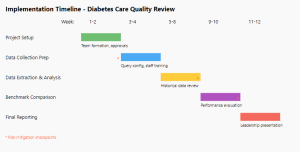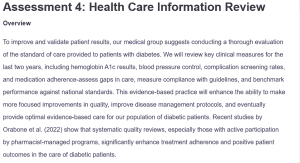Assessment 4: Health Care Information Review
Overview
To improve and validate patient results, our medical group suggests conducting a thorough evaluation of the standard of care provided to patients with diabetes. We will review key clinical measures for the last two years, including hemoglobin A1c results, blood pressure control, complication screening rates, and medication adherence-assess gaps in care, measure compliance with guidelines, and benchmark performance against national standards. This evidence-based practice will enhance the ability to make more focused improvements in quality, improve disease management protocols, and eventually provide optimal evidence-based care for our population of diabetic patients. Recent studies by Orabone et al. (2022) show that systematic quality reviews, especially those with active participation by pharmacist-managed programs, significantly enhance treatment adherence and positive patient outcomes in the care of diabetic patients.
Key Study Components
Data Collection Plan
We will utilize the EHR, Practice Management System, Laboratory Information System, and Pharmacy System to source comprehensive clinical data on all type 1 and type 2 diabetes patients from January 2022 through December 2023. Data extraction and analysis will be performed by a dedicated specialist team of data analysts, experts in quality improvement, and IT support according to uniform protocols. We will adhere to ElSayed et al.’s (2022) guidance from the ADA Standards of Care to ensure that our data collection aligns with the current best practice in managing population health for diabetes care.
Data Security Plan
We have taken concrete steps to ensure data security; all patient health information will be encrypted in transit and at rest, with strict access controls. Reporting will only be done on an aggregate level where individuals are deidentified, and comprehensive HIPAA compliance training will be provided for all staff involved. We would follow this by maintaining extensive audit trails and updating all the concerned privacy policies and Business Associate Agreements. We can then safely implement new care approaches, such as those mobile health interventions that proved effective in the study by Gerber et al. (2023), knowing that the privacy of patients and data security will not be divulged.
Benchmarking Plan
We will use national benchmarking from NCQA HEDIS measures, CMS Quality Rating System, and ADA Standards of Care. The data is being harmonized with the nationwide standards through LOINC codes and consistent measurement methodologies. This way, the key diabetes quality indicators will be comparably valid. Notably, according to ElSayed et al. (2022), the comparison will be meaningful since the alignment with national standards will provide areas of improvement.
Quality and Change Management Strategies
Evidence-based strategies that target these areas involve rapid-cycle PDSA improvements, optimization of EHR workflows based on best practices of high performers, and enhanced patient education programs. We are widening our care teams to include clinical pharmacists; this extends our medication management to better include patient education, a successful model presented in Orabone et al. (2022). Additionally, mobile health interventions will be explored, which Gerber et al. (2023) have found to be particularly effective in improving glycemic control across diverse patient populations.
Conclusion
This systematic review will significantly raise our level of care regarding diabetes through objective performance data, the identification of specific opportunities for improvement, and the institution of evidence-based best practices. By incorporating pharmacist-managed programs, as Orabone et al. (2022) presented, an ADA-emphasized Chronic Care Model, as put forth by ElSayed et al. (2022) and studying new mobile health solutions, as confirmed by Gerber et al. (2023), we will further develop our care processes in our pursuit of improved glycemic control, reduced complications, and better overall health outcomes for our patients with diabetes. By its very nature, this approach will place our physician group at the front in quality diabetes care provision, yet at the same time, ensure that we are meeting and surpassing national standards of care.
References
ElSayed, N. A., Aleppo, G., Aroda, V. R., Bannuru, R. R., Brown, F. M., Bruemmer, D., Collins, B. S., Hilliard, M. E., Isaacs, D., Johnson, E. L., Kahan, S., Khunti, K., Leon, J., Lyons, S. K., Perry, M. L., Prahalad, P., Pratley, R. E., Seley, J. J., Stanton, R. C., & Gabbay, R. A. (2022). Improving care and promoting health in populations: Standards of care in diabetes—2023. Diabetes Care, 46(1), 10–18. https://doi.org/10.2337/dc23-s001
Gerber, B. S., Biggers, A., Tilton, J. J., Smith, D. E., Lane, R., Mihăilescu, D., Lee, J.-A., & Sharp, L. K. (2023). Mobile Health Intervention in Patients With Type 2 Diabetes. JAMA Network Open, 6(9), e2333629–e2333629. https://doi.org/10.1001/jamanetworkopen.2023.33629
Orabone, A. W., Do, V., & Cohen, E. (2022). Pharmacist-Managed Diabetes Programs: Improving Treatment Adherence and Patient Outcomes. Diabetes, Metabolic Syndrome and Obesity: Targets and Therapy, Volume 15, 1911–1923. https://doi.org/10.2147/dmso.s342936

ORDER A PLAGIARISM-FREE PAPER HERE
We’ll write everything from scratch
Question 
Write an executive summary (1–2 pages) for senior leaders that highlights key information about the proposed health care information review of the quality of care given to a specific population. Detail the proposed implementation steps and associated time frames in a Gantt chart (one-page chart).
Introduction
As the office manager of your physician group, you realize that obtaining funding for your proposal will require the approval of the physician group’s senior leaders. You and the others helping you implement the proposal will need the details your proposal contains. From experience, however, you have learned the senior leaders will not take the time to review all the details. For them to approve your proposal, they simply want the highlights of what you plan to do, a brief explanation of how it will identify the quality of patient care, and the amount of time it will take to complete the study. In this final assessment, you will prepare a summary report for the senior leaders of your physician group. Your summary report is an abbreviated version of your proposal.
Please carefully review this assessment’s scoring guide to better understand the performance levels relating to each criterion on which you will be evaluated.
Instructions
Download and use the Summary Report Template [DOCX]. You will complete this assessment by replacing all italicized instructional text with your own words.
Summary Report
- Overview
- State your proposal’s big idea in the Overview.
- Explain the information you plan to collect and the reasons why it is important to collect it.
- Describe how this information could validate the quality of care delivered by your facility.
- Note: Your Overview needs to be shorter than the Introduction from your proposal. Remember: the entire narrative portion of your Summary Report needs to be less than two pages. You will have an additional page for your Gantt chart.
- Key Study Components
- Include a subheading labeled Data Collection Plan.
- Distill down into one or two sentences the most important information about your implementation plan and the information you plan to collect at your facility.
- Include a subheading labeled Data Security Plan.
- Highlight in one or two sentences the most important information about your plan to ensure data security that your senior leaders need to know.
- Include a subheading labeled Benchmarking Plan.
- Provide a one- or two-sentence overview about the best practices (benchmarks that will be used) and procedures your study will use to ensure the data you collect meets standards for interoperability with an HIE.
- Include a subheading labeled Quality and Change Management Strategies.
- Summarize in one or two sentences how your plan incorporates quality and change management strategies.
- Include a subheading labeled Data Collection Plan.
- Conclusion
- State how your proposed study will improve the quality of patient care delivered by your physician group. Your Conclusion needs to be one paragraph of no more than five or six sentences.
- Reference
- List one reference in APA format to benefit your senior leaders.
- Gantt Chart
- Include with your Summary Report a one-page Gantt chart that specifies the major steps in your implementation plan and the time frame associated with each step. Microsoft Excel is one tool you can use to create your chart. Your suggested readings supply additional information about how to create a Gantt chart in Excel. Please feel free to use other tools. The only requirement is that your Gantt chart specify the major steps in your implementation plan and the time frame associated with each step.

Assessment 4: Health Care Information Review
- Include with your Summary Report a one-page Gantt chart that specifies the major steps in your implementation plan and the time frame associated with each step. Microsoft Excel is one tool you can use to create your chart. Your suggested readings supply additional information about how to create a Gantt chart in Excel. Please feel free to use other tools. The only requirement is that your Gantt chart specify the major steps in your implementation plan and the time frame associated with each step.
Additional Requirements
- Written communication: Your executive summary must be concise, clear, and well organized, with correct spelling, grammar, and syntax, to support orderly exposition of content. Use the Summary Report Template.
- Assessment Title: You may devise your own title of 5–15 words for the executive summary or use Summary Report – Health Care Information Review. Enter the other required information specified on the template.
- References: Specify one peer-reviewed reference that will benefit your senior leaders in the appropriate space on your template. Your reference should conform to APA formatting.
- Length: 1–2 typed, single-spaced pages. The narrative portion of your summary report should be preferably one page; it should not exceed two pages. You will have an additional page containing your Gantt chart.
- Font and font size: Times New Roman, 12 point.
Competencies Measured
By successfully completing this assessment, you will demonstrate your proficiency in the following course competencies and scoring guide criteria:
- Competency 1: Determine stages of the information lifecycle embedded within health information management technology functions.
- Create a Gantt chart detailing the steps and time frames for study implementation.
- Competency 2: Apply laws governing health information confidentiality, privacy, and security.
- Describe how the plan will implement data security measures.
- Competency 3: Assess system applications used to operationalize health information.
- Explain rationale for proposed health care information review study.
- Specify what information will be collected and from which applications.
- Summarize how the proposed study will improve the quality of care delivered by the physician group.
- Competency 4: Determine how a health information exchange (HIE) or other external health care databases affect the management of patient data, clinical knowledge, and population data.
- Design evidence-based best practices to ensure data meet interoperability standards with an HIE.
- Competency 5: Apply quality and change management concepts to health care information management.
- Incorporate evidence-based quality and change management strategies.
- Competency 6: Communicate in a manner that is scholarly, professional, respectful of the diversity, dignity, and integrity of others, and is consistent with the expectations for healthcare professionals.
- Write clearly, with correct spelling, grammar, and syntax, and good organization.
- Apply proper APA formatting and style to citations and references.
